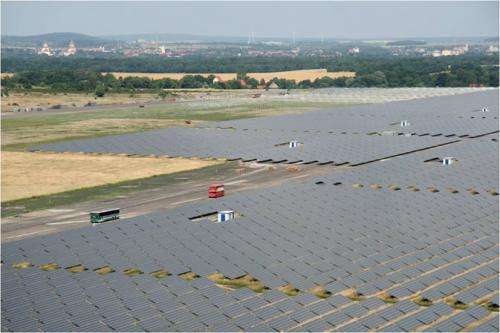September 1, 2015 report
Study looks at immediate health benefits of renewable energy plants

(Phys.org)—A team of researchers with affiliations to several institutions in the Boston area has conducted a study to determine the immediate health benefits to different parts of the country if coal or gas fired plants were replaced with solar or wind farms. In their paper published in the journal Nature Climate Change, the team describes how they created their models and why they believe they could be used to help with planning energy systems in the future.
As the researchers note, most studies that look into the benefits of converting "dirty" energy production to "clean" renewable resource based systems, focus on the benefit to the planet as a whole, i.e. reducing greenhouse gas emissions and thus slowing global warming. They suggest another approach is to look at the health benefits that would occur for the people that live in the area—air pollution, it has been estimated kills approximately 200,000 people in the U.S. each year—and a lot of that pollution comes from coal fired power plants. In this new effort, the researchers wondered if it might be possible to create models that would reflect the immediate health benefits to people that live in the vicinity of dirty plants if they were replaced with non-air polluting plants.
As a start, the team chose to use dollar amounts spent on health care due to pollution as a metric, because it can be quantified. Next, they chose six geographical areas to evaluate: Cincinnati, northern Ohio, Virginia, Pennsylvania, southern New Jersey and Chicago. For each of those areas, the team looked at what the impact would be of replacing a coal fired plant with either a 50 MW solar or wind plant, or two pollution reduction schemes that would involve reducing the amount of electricity meted out to customers. Then, they looked at the impact that each of the types of projects would have on the amount of electricity generated versus savings or constraints on the local grid, and of course the difference in emission of pollutants such as nitrogen oxide, carbon dioxide and sulfur dioxide.
Putting it all together resulted in a model that they could use to estimate the health benefits (in dollars) under each of the different scenarios. They found it was different for each region depending mostly on population density and baseline pollution levels—savings ranged from $5.7 to $210 million each year. The researchers believe their models could be used by planners to forecast potential health benefits when considering power generation options in the future.
More information: Health and climate benefits of different energy-efficiency and renewable energy choices, Nature Climate Change (2015) DOI: 10.1038/nclimate2771
Abstract
Energy efficiency (EE) and renewable energy (RE) can benefit public health and the climate by displacing emissions from fossil-fuelled electrical generating units (EGUs). Benefits can vary substantially by EE/RE installation type and location, due to differing electricity generation or savings by location, characteristics of the electrical grid and displaced power plants, along with population patterns. However, previous studies have not formally examined how these dimensions individually and jointly contribute to variability in benefits across locations or EE/RE types. Here, we develop and demonstrate a high-resolution model to simulate and compare the monetized public health and climate benefits of four different illustrative EE/RE installation types in six different locations within the Mid-Atlantic and Lower Great Lakes of the United States. Annual benefits using central estimates for all pathways ranged from US$5.7–US$210 million (US$14–US$170 MWh−1), emphasizing the importance of site-specific information in accurately estimating public health and climate benefits of EE/RE efforts.
Journal information: Nature Climate Change
© 2015 Phys.org



















